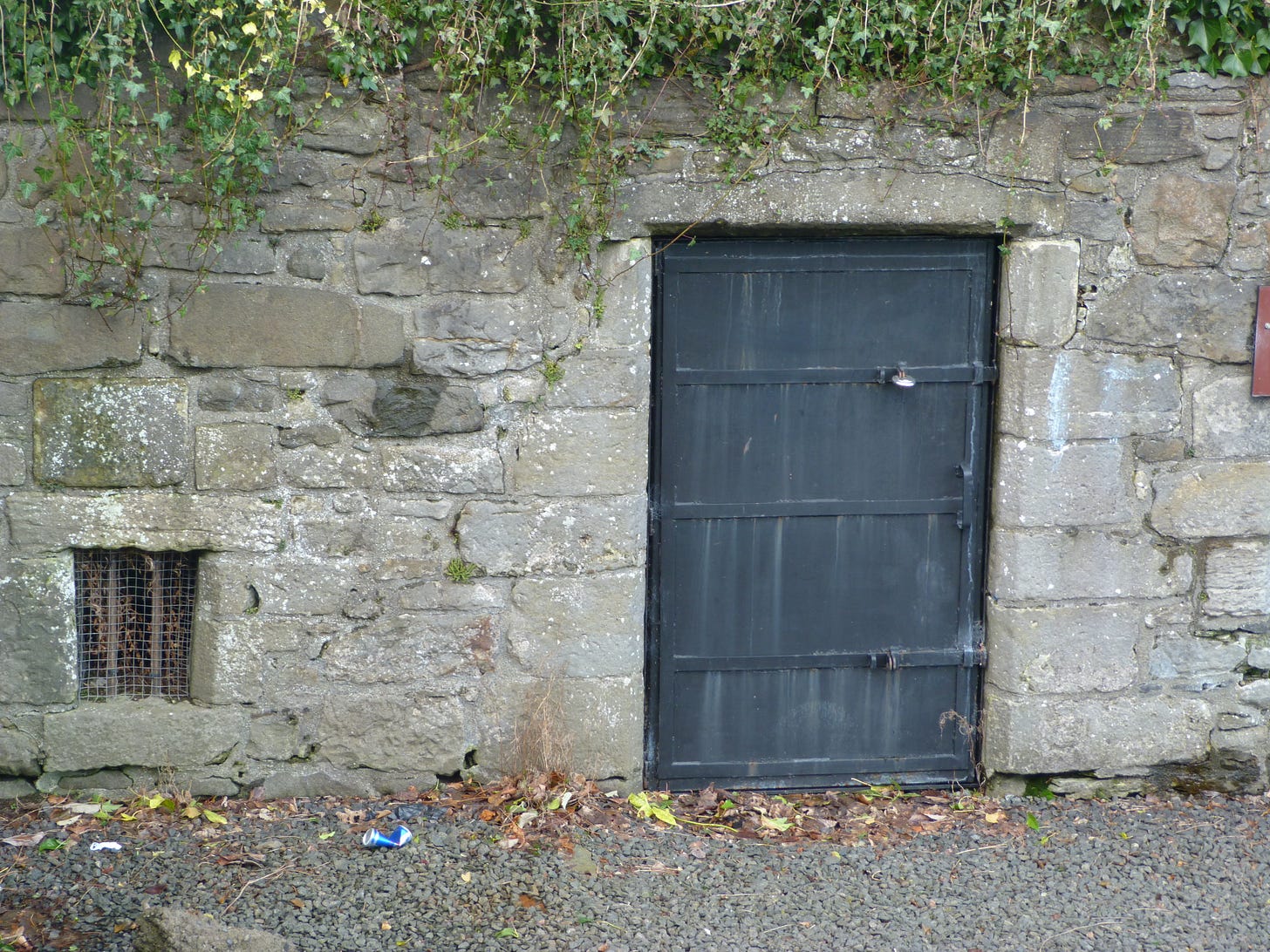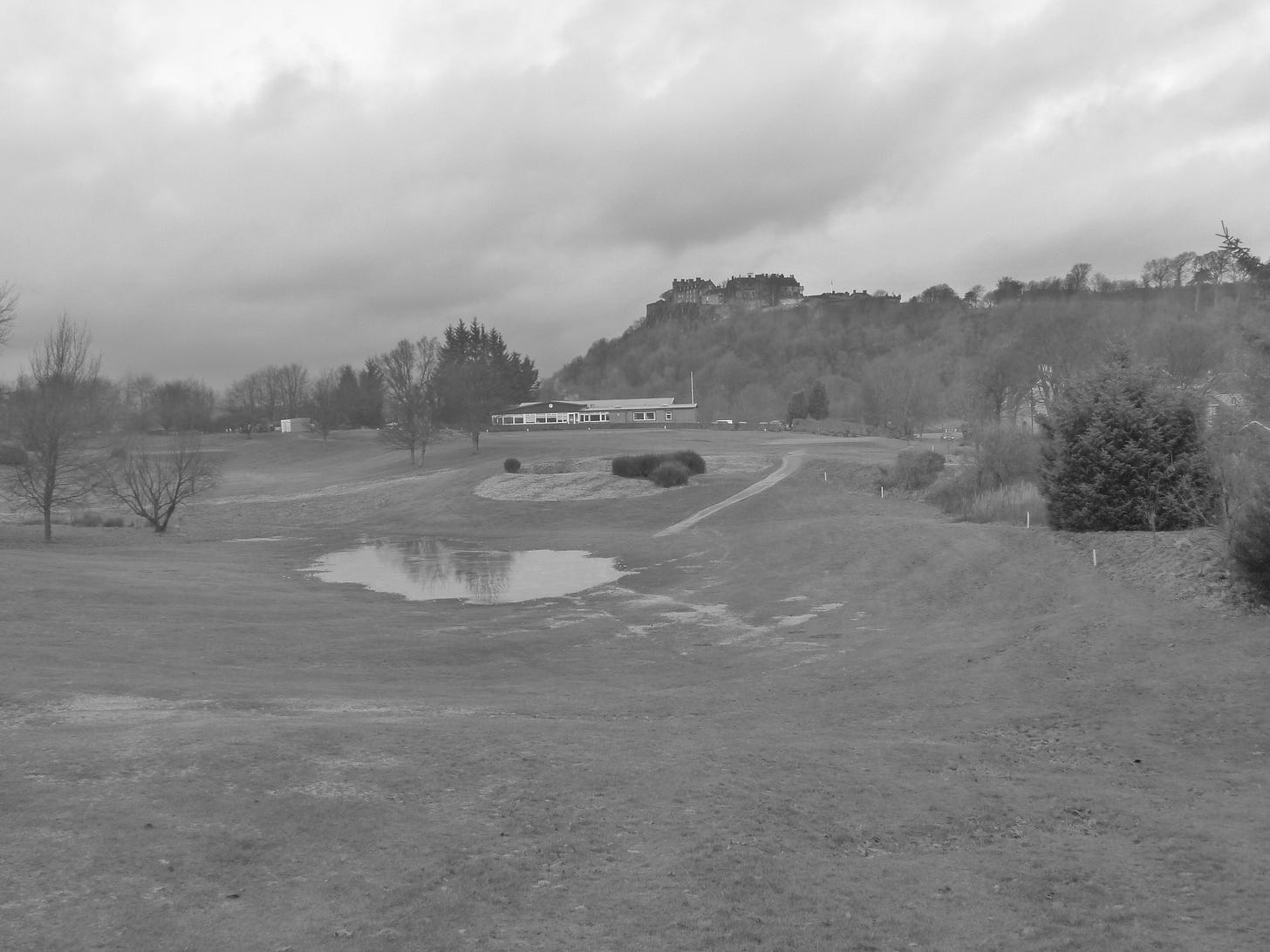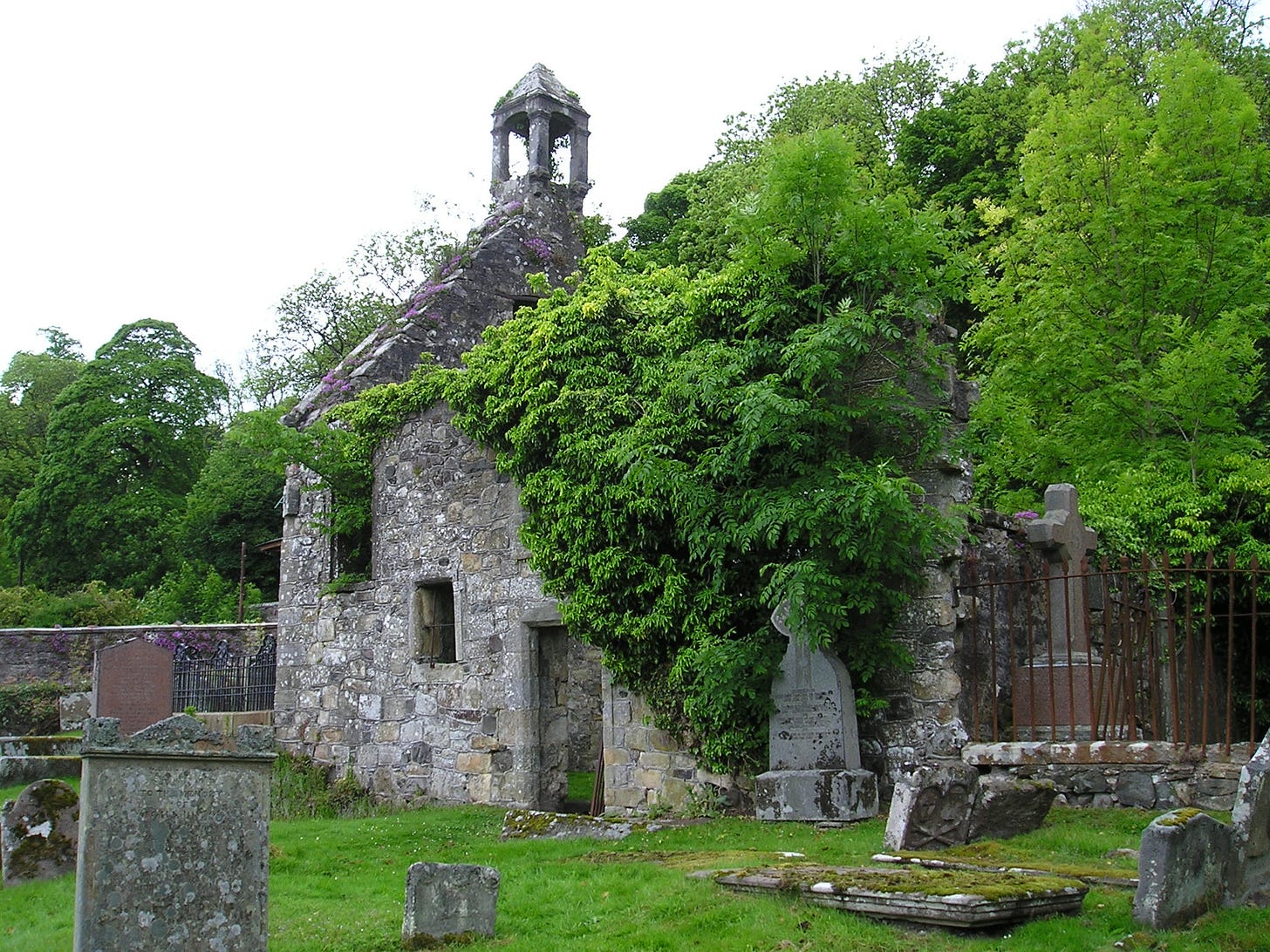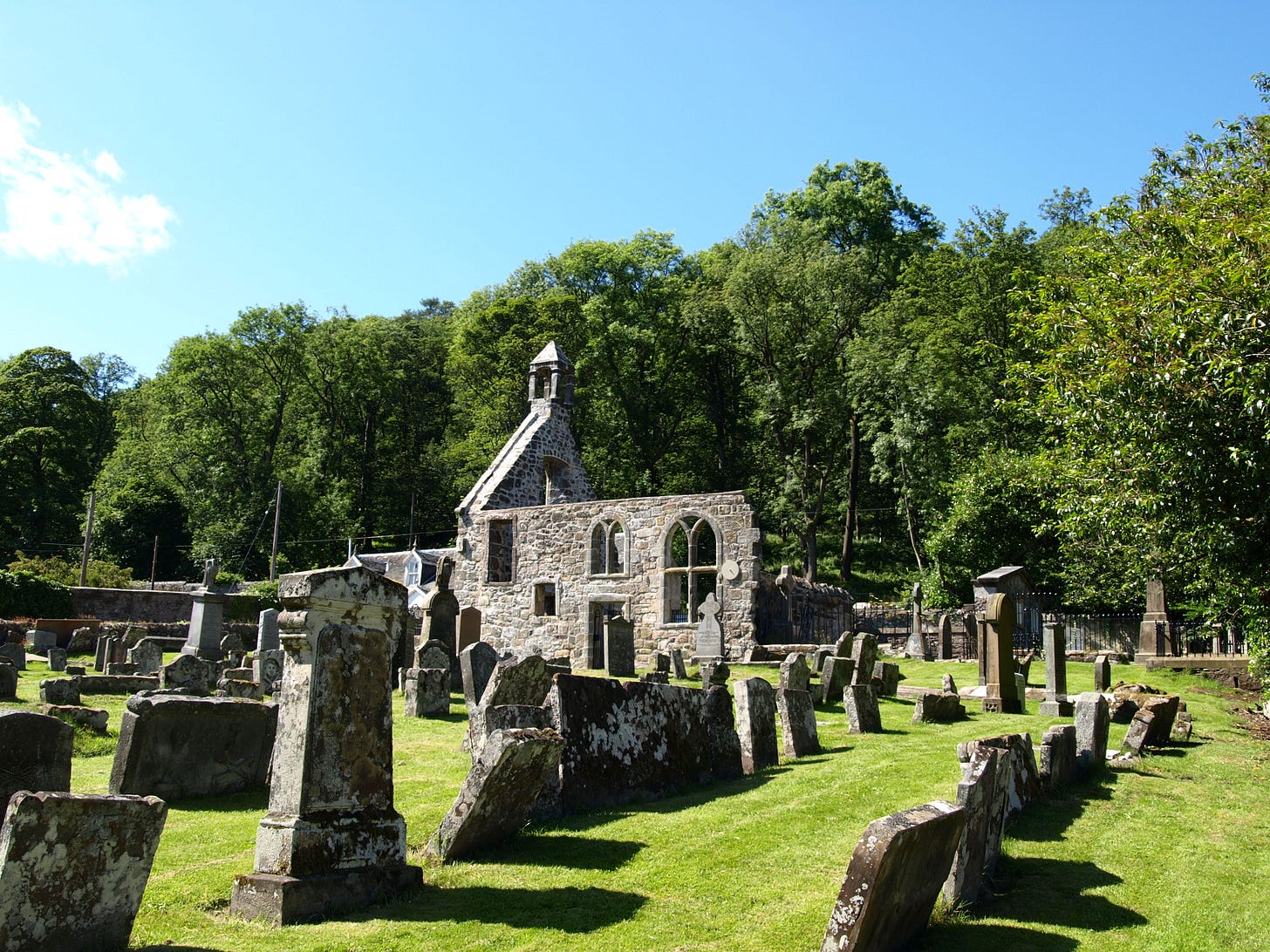Welcome to my regular piece of research, the second of two weekly blogs I publish. The Monday newsletter summarises of all the interesting history and archaeological things happening round Stirling. These are both free but if you like what I do, you can support the expenses of my archaeological digs by becoming a paid subscriber, which gives you exclusive access to the results. Regardless I hope you enjoy the blog and perhaps you’ll come along to a dig sometime!
A change of pace this week….the five generally overlooked historic things in Stirling (the city not the Council area) which is of course heavily biased to my own tastes! Each entry contains a link to the location of the key feature…..oh and they’re in no particular order!
Number 1: Stirling’s Oldest Cemetery and Resident.
6-4000 years ago the low lying dip between King’s Park Golf Course and Cambusbarron was a sandy bay on a lost inland sea. The water level was higher and there were whales at Gargunnock and oyster beds in Bridge of Allan. This was a good place to live (it still is), the land could be easily ploughed and there were things to eat in the sea. So the people who lived here buried their dead here which affirmed their ownership because great-great-granny was buried over there. There have been a number of burials found across this area over the last 100 years and it looks like a cemetery stretched from the narrow passage into King’s Park at Douglas Gardens to Coneypark.
The one upstanding example is at Coneypark initially disturbed in 1879 by workmen who were looking for gravel when they found the remains of a stone box or burial cist with a skeleton in it. The skeleton was stored in The Smith Museum and Art Gallery. The mound was threatened with development in 1972 and the local society dug into it again, finding a second cist and more remains including those of a four to five year old child. In 2018, the main skull from the cist was reconstructed by local student Emily McCulloch. The Museum’s curator Michael McGinnes called him Torbrex Tam, even though he really should be Coneypark Callum! At this point I got involved and suggested getting the bones radiocarbon dated and reanalysed. This revealed three adults in the original cist, two of whom dated to around 2000 BC and so we confirmed that Tam is Stirling’s oldest resident!
Number 2: The Scene of the ‘Crime’…the spot of a17th century witchcraft confession.
Now I don’t believe in witchcraft, its a non-crime and the fact that Scotland persecuted a greater proportion per-head of its population than anywhere else in Europe is a stain on our collective souls.
Like all cities, Stirling has lots of parking and in the top corner of the Wellgreen Carpark (opposite the multi-story tower) is a truncated ruin of a building with a black door. If you stand next to it you can hear the flow of water; this is St Ninian’s Well which sat on a green field, hence ‘Well Green’. This was the main source of water for this side of town and locals talk about Robert the Bruce being blessed here at the Battle of Bannockburn. It is also the scene of a confessed act of witchcraft, described in what was Stirling’s biggest ever witch trial in October 1659 for which the defendant, one Bessie Stevenson, was found guilty and executed.
So, what exactly did poor Bessie Stevenson confess to? We know all about it because of the court records and if you are particularly interested in witchcraft, Edinburgh University has a witch data base which records all Scotland’s witchcraft court cases. Bessie took the clothing from a sick friend and washed them at the well on Well Green, absorbed the disease into herself and then transferred it to anyone she met on the way back. She also laid foxgloves under people’s heads and middles, all of which was presumably to help cure disease. Now, we don’t know if Bessie thought she was a witch, or if she was mentally ill, or if she had simply been tortured into confessing something with leading questions. Whatever the truth she did not deserve to die and her torture and execution were crimes for which we should all be ashamed.
Number 3: Stirling’s Lost Royal Loch.
Say it loud and say it proud…Stirling is home to Scotland’s oldest and best preserved Royal Park. Founded in the 12th century by William the Lion, the park was a mixture of pleasure ground and estate, significantly is maintained an open view from the Castle to the west. The park has changed over the years and has a number of key elements: the King’s Knot, the deer dyke, the King’s Park (the public Park), Kings Park (the residential area) and Gowan Hill.
A wonderful little element of the park was its loch, (one of two) which currently forms the bane of the gold club and it fills up every winter! The loch was designed to be filled by surface rain water and its extent and history is described here by local archaeologist and historian Stephen Digney. The water is held in place by a dam which later formed the base for the horse race track.
John Wood’s 1820 map of Stirling from the National Map Library of Scotland.
Number 4: Logie Old Kirk.
Now a confession before we begin, I’m the chair of the Friends of Logie Old Kirk and if you have time to help please get involved. This is a wonderful location in the lee of the Ochils which was saved from destruction by locals Joe and Eleanor Young, who are an absolute inspiration. The church was overgrown and memorials dangerous so the Council locked it….enter stage left our heroes.
Anyway Logie is a great wee place open all year round and featuring an amazing set of 17th and 18th century gravestones and the great and good of Victorian Bridge of Allan, many of who made their fame and fortune across the British Empire. However, the whole place is far older…that name Logie which is normally Gaelic for hollow in this case is a corruption of the Latin Locus which means place as in Holy Place. Professor Thomas Clancy of Glasgow University has argued that these locus logies are associated with the Pictish expansion after 685 and the Battle of Dunnichen. Ie an attempt to use religion to reinforce political control. Now if that were not enough to tempt you there are also up two four hogbacks which are a burial monument with Viking origins popular in the 10th century.
Three of the up to four hogbacks!
Number 5: The Hermitage.
Now this one really is a secret, hard to get to and until very recently hidden by trees, brush and litter until we helped clear and record it!
The Hermitage in the grounds of the University, is a folly built in the late 18th century built by Robert Haldane. Robert came from a line of East India Company Captains and inherited two fortunes: his great Uncle and his father. His teens were very restless and he first went to university, then the military, then a great tour of Europe, then back to University before marrying and working on the estate when he was 22. The Haldane family were the equivalent of billionaires, Robert had money and time on his hands. After 15 years in Bridge of Allan he had a religious epiphany and sold the estate to focus on preaching and philanthropy…..think Bill Gates.
The Hermitage was built in those 15 years and almost immediately abandoned by the next owner, it appears to have been a fashionable whim and perhaps even a joke. It was designed as an immersive poetry experience, perhaps echoing the more famous Dunkeld Hermitage. The lines of Oliver Goldmsith’s poem the Hermit, from his block-buster book The Vicar of Wakefield, were written on the walls and as you went into the building the central scene from the poem was recreated with fake furniture and smoke from a fire. Then after this there would be the stunning view across his estate framed by Abbey Craig in the east and the Castle in the west and presumably servants to bring tea and buns! This is a bit like us asking friends to come into the garden at night and turning on lights in a tree….but at an astonishingly bigger scale.











